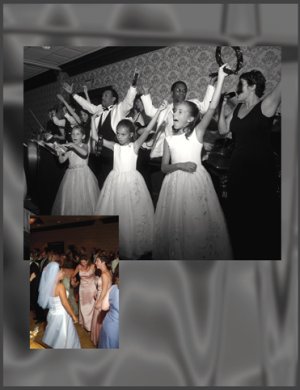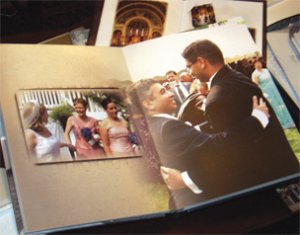articles/Digital/digitaltalkingplunge3-page2
Digital Taking the plunge Part 3 - part 2 of 1 2
by Mike McNamee Published 01/03/2003

After all the prints are made and delivered, I purge the files from the computer to make room for the next job. So the process continues, the templates of course are reusable, I created them in Photoshop, using a bit of trial and error, by first opening an new document, sizing it to the page size I would be working with and then using various method the fill the canvas with soft detail, I will add distortions and filters and finally I will blur the image before saving it as a template.psd Next I will drag, drop and resize one or more of my images onto the canvas, add such effects, perhaps as a drop shadow or bevelled edge, maybe a little rotation. Finally I flatten the image and save as a TIFF to send to the lab. All my wedding albums will go through one or the other of these two avenues.
As yet I haven't gone into inkjet printing, but I am beginning to take it very seriously, I do intend to make a purchase within the next few weeks. It is quite funny really until a very short time ago ink jet prints were considered very low end and undesirable, but in true American fashions someone has to come up with a posh sounding esoteric name that no one knows the meaning of and suddenly Giclee prints are rather expensive and somewhat sought after in the right circle. Of course those who've getten edificated like what we done, know that Giclee is just French for a common or garden ink jet... but SHHHH don't let it out, the Americans are still falling for Giclee like it was something hand stencilled onto Papyrus by a thousand year old Egyptian, it is so amusing listening to them.
Clearly with all the fine art style media and the newer Ultrachrome inks, in house printing is becoming an attractive proposition. The price of doing it one's self, sadly, will never rival the low cost of silver halide printing, but then you can't have it both ways. A mini printer and paper processor for chromogenic paper would run into several thousand pounds, add a couple of chemical mixers and a water panel... Hey hold on, a really good ink jet printer only costs a few hundred, just how many ink cartridges would you have to use before you reach the cost of a 1970's mini lab?
I am sure it is only a matter of a very short time before the album manufacturers see the writing on the wall and start to produce ink jet printable album pages that can be bound into a first class presentation(they do - Ed.) But for now ink jet prints have more than enough applications to be going on with as the range of available substrates continue to increase to include fine art canvas, water colour paper and an incredible assortment of others.
My personal favourite product is the plain old picture CD, it costs me next to nothing to make, I get paid handsomely for producing the images I burn to it. The last half dozen commercial jobs haven't even asked for a paper proof, they just wanted the CDs in a hurry and the fact that I can deliver them the same day as the shoot, just bowls the clients over. Mostly they want CMYK (colour separated files) for reproduction in advertisements, occasionally low resolution files for a web site, but can you imagine shooting a couple of thousand pounds worth of work and only spending two quid on production... including postage - this should have come earlier in my career I tell you!
Finally: if this three part introduction to digital, hasn't convinced you that it is time to take this new medium seriously, then I have some very good eye wash solution that works great, even when the head is buried three feet under sand. It may be that you are waiting to see just what the pitfalls are that I mentioned at the beginning of this editorial, well just like any system or process, things can go wrong and from time to time do. Compact Flash storage cards and Microdrives are both very susceptible to failure. Very early on in your transition to digital you should look for and make contact with a good data recovery service.

Compact Flash costs considerably more than Microdrive so there is an immediate temptation to save money, that is OK, because according to the experts at Drive Savers, California's premier recovery service, both break down with equal regularity. However, recovery from a Compact Flash cards costs about 1/3rd of the recovery from a Microdrive. Even though I own four one gigabyte Microdrives, that information alone motivated me to invest in a handful of 512 megabyte Compact Flash cards, having just spent more than double the cost of a Microdrive on a 100% successful recovery job a few weeks ago.
Join the digital groups, ask questions, log onto to a digital forum, they are all over the web and some are full of worthwhile information, but above all network with your fellow professionals and attend the meetings and seminars. Take every step you can the accelerate the learning curve, remember some cameras are more intuitive than others, but they all take longer to get to know than a completely manual film camera, just because of all the electronic functions.
The only thing that really matters in your choice of camera is how it will fit into your workflow, not the whistles bells and flashing lights, not the price, not even the name. I covered six weddings earlier this year with an Olympus E-20N and it did a great job, despite the latency. I am a lot more comfortable with my S2, just because of the speed and the slightly larger file size. What is more I could use almost any high end digicam and get superb results, not because of anything I do, but because they are all so well designed in their own right.
Take it from me that tomorrow is here today, the fiscal health of your business is going to be utterly dependant on your products and services being current, the days when you wait just a little longer are rapidly running out. You should make 2003 the year and yes, the current camera models will come down in price during the new year, but only because they will have been replaced by the next generation, but they will still be good enough to make you a lot of money, if you don't care about being on the cutting edge, not only is time running out, so are your excuses. Go for it!
This is the final part of David's series on going digital. He can be contacted on pix4bux@msn.com. He lives in the Chicago area in the USA
Please Note:
There is more than one page for this Article.
You are currently on page 2 Contact Mike McNamee
1st Published 01/03/2003
last update 09/12/2022 14:53:21
More Digital Articles
There are 36 days to get ready for The Society of Photographers Convention and Trade Show at The Novotel London West, Hammersmith ...
which starts on Wednesday 14th January 2026





